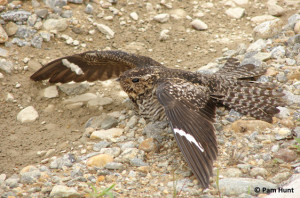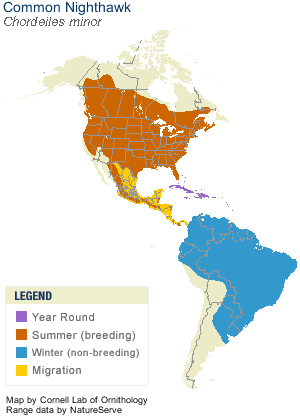Distribution and Migration
Despite what their name suggests, Common Nighthawks are most active during twilight rather than night, and are not close relatives of hawks. They are sometimes referred to as bullbats, due to their bat-like flying patterns and the loud whooshing sound they make with their wings. These birds are often observed in flight pursuing insects.
Common Nighthawks have a large breeding range that spans most of continental North America (including the Maritimes), stopping in the northern Canadian territories and extending into Central America. These birds overwinter in South America, most commonly in eastern Peru, Ecuador, and southern Brazil.
37% of Common Nighthawk breeding grounds are located in Canada, though only 10% of the population of the species actually breeds in Canada. Within Canada, most individuals breed in southern Labrador.
Breeding and Life History
Common Nighthawks arrive on their Nova Scotian breeding grounds in May. Their breeding season is short, usually lasting only two months. They begin the migration to their South American breeding grounds in July and often travel in large groups (numbers in the 1000s) during migration.
Males mark their territories by “booming” their wings – pushing wings downward while veering up from a dive. This creates air movement over the wings and a deep sound. This sound also attracts females and may discourage interference by other species. Territories range in size from very small at 4 h, to very large at 259 ha. 
Though Common Nighthawks most commonly nest on bare, rocky grounds (rock barrens, open woodland, blueberry fields, and pastures), they also frequently nest in man-made environments such as flat gravel roofs. They do not build nests but rather lay their eggs directly on the ground or occasionally in woody debris. Eggs are hidden by their camouflage colouration. Unfortunately, the lack of protection from a nest leaves eggs vulnerable to predation by not only by other bird species such as American Crows and Peregrine Falcons, but also to dogs, raccoons, skunks, snakes, foxes, and other ground-dwelling creatures.
Conservation
Between 1968 and 2005 the Common Nighthawk population in Canada has suffered a decline of about 50%. Between 2002 and 2012 the annual rate of decline was 2.26% in Canada. In Nova Scotia, the decline has been higher at 3.52% per year.
The widespread use of insecticides in both agricultural and urban areas has affected the primary food source of Common Nighthawks – flying insects. It has been suggested that insecticide use may be a contributing factor in the overall decline in this species, though currently there is no direct evidence of this.
Much about the life history Common Nighthawk remains poorly understood, especially in the southernmost part of their range and wintering grounds. More information about this species is required in order to make informed decisions about their conservation.
Conservation status of this species nationally and in Atlantic Canada:
| COSEWIC | Threatened |
| SARA | Threatened (Schedule 1) |
| Nova Scotia | Theatened |



